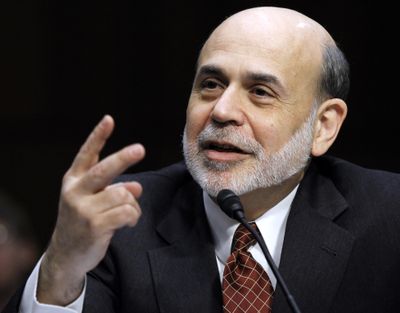Fed to meet at time of widening risk
Opponents of bond purchases worry about fueling inflation

WASHINGTON – Higher oil and food prices. Unemployment near 9 percent. Crises in the Middle East and Japan.
The U.S. economy faces threats at home and abroad that have the potential to dull growth or stoke inflation. Or both.
When they meet today, Chairman Ben Bernanke and his Federal Reserve colleagues will debate those risks. At the top of their agenda is whether to make any changes to the Fed’s $600 billion Treasury bond-purchase program, which is set to expire at the end of June. The bond purchases are intended to help the economy by keeping long-term interest rates down, encouraging spending and driving up stock prices.
Economists think the Fed will agree to maintain the pace and size of the bond purchases. But the risks for the economy will likely complicate Bernanke’s efforts to forge consensus.
The Fed chief and a majority of his colleagues argue that the economy still needs support from the bond purchases, especially with unemployment still high and home prices in many areas depressed.
But a vocal minority on the Fed has raised concerns that the bond purchases, combined with higher prices for food, fuel and other commodities, will spread inflation through the economy. They also say they worry that the purchases could feed speculative buying that could inflate new bubbles in the prices of stocks or other assets.
Charles Plosser, president of the Federal Reserve Bank of Philadelphia, has said he may push for an early end to the bond-buying program. And Richard Fisher, president of the Federal Reserve Bank of Dallas, has said he might push to scale back the bond purchases.
A contentious debate is expected today. If, as expected, Bernanke prevails and the Fed decides to keep the bond-buying program intact, Plosser and Fisher might dissent.
“The recent spike in oil prices makes the Fed’s job that much more difficult,” said Victor Li, associate professor of economics at Villanova School of Business. “The Fed’s hope is that rising prices and inflation will accompany sustained and robust economic growth. However, rising energy prices may lead to a situation of stagflation: higher inflation and lower growth.”
Upheaval in the Middle East has sent oil and gasoline prices up. A sustained run-up in those prices could cause Americans to reduce spending on other items and slow the economy.
Bernanke has predicted that rising oil prices will cause only a brief and slight rise in consumer inflation. But he’s warned that any prolonged surge in oil prices would pose a danger to the recovery. Other potential risks have emerged, from a slowdown in U.S. growth to renewed worries about Europe’s debt problems to economic effects from the earthquake and nuclear crisis in Japan.
When the Fed last met in late January, optimism about the U.S. recovery was rising. Fed officials predicted the economy would grow at a faster pace this year – between 3.4 percent and 3.9 percent. Even so, unemployment would stay elevated – at best dropping only to 7.7 percent by the end of 2012.
Fortified by tax cuts, Americans are spending more. Retail sales grew strongly in February, marking the eight straight monthly increase. Businesses are hiring more. The unemployment rate has fallen nearly a full percentage point in just three months – the sharpest drop in a generation.
Still, some economists are now lowering their forecasts for growth in the first three months of this year because they think high energy prices will slow consumer spending. JPMorgan Chase now predicts growth in the January-March quarter of just 2.5 percent, down from 3.5 percent. It’s also lowered its projection for the April-June quarter.